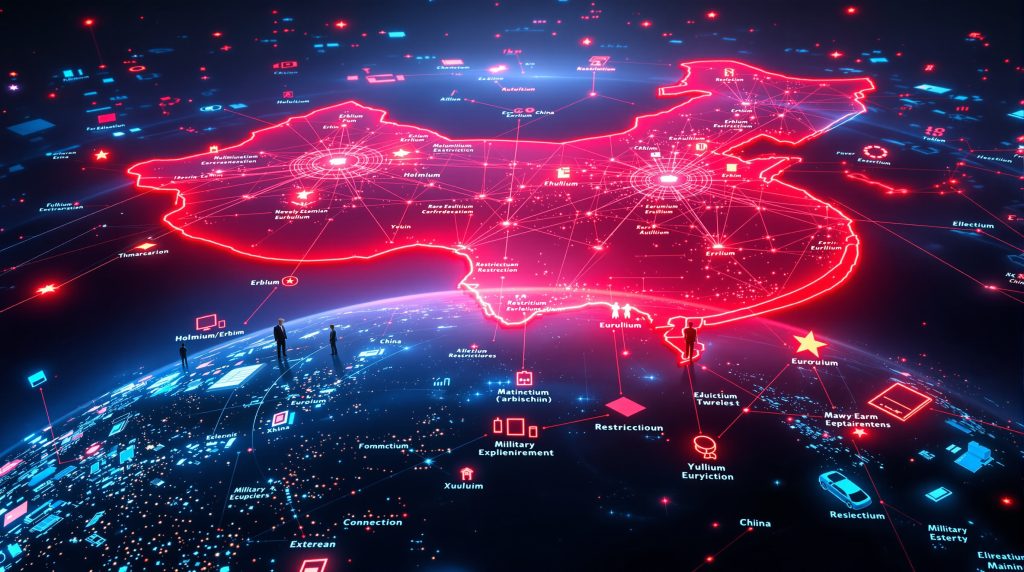How Are China's New Rare Earth Export Controls Reshaping Global Supply Chains?
China has significantly expanded its rare earth export restrictions, adding five additional elements to its control list and implementing stricter regulations targeting semiconductor industry users. This strategic move comes at a critical time as US‑China trade impacts escalate and global supply chains face mounting pressure.
The Chinese Ministry of Commerce announced on October 9, 2025, that it would extend export controls to include five more rare earth elements, bringing the total number of restricted elements to 12. These new measures, scheduled to take effect in November and December 2025, represent one of the most significant changes to global rare earth supply chains in years.
Understanding Rare Earth Elements in the Global Economy
Rare earth elements comprise a family of 17 metals that, despite their name, are relatively abundant in the Earth's crust. However, they typically occur in low concentrations, making economically viable deposits uncommon and processing environmentally challenging.
These elements are crucial components in manufacturing high-tech products including electric vehicles, wind turbines, smartphones, and military equipment. Their unique magnetic, luminescent, and electrochemical properties make them irreplaceable in many advanced technologies.
China currently dominates the global rare earth market, producing more than 90% of the world's processed rare earths. This dominance stems from decades of strategic investment in mining operations and processing facilities while accepting environmental consequences that other nations have largely avoided.
The country's control over this critical minerals energy chain has given it extraordinary leverage in global technology markets, with implications for industries ranging from clean energy to defense.
Critical Applications Across Industries
Rare earth elements serve essential functions in numerous applications:
- Neodymium and praseodymium: Used in powerful permanent magnets for electric vehicle motors and wind turbines
- Lanthanum and cerium: Critical for catalytic converters and petroleum refining
- Europium and yttrium: Essential for color displays in smartphones and televisions
- Terbium and dysprosium: Crucial for stabilizing magnets at high temperatures in defense applications
- Gadolinium: Used in medical imaging technologies like MRI machines
China's Expanding Control Mechanism: What's New in 2025?
The Chinese Ministry of Commerce has expanded its rare earths export control list to include five additional elements: holmium, erbium, thulium, europium, and ytterbium. This brings the total number of restricted rare earth elements to 12, representing over 70% of the rare earth family.
Holmium is used in specialized magnets and nuclear control rods, while erbium is essential for fiber optic communications. Thulium, one of the rarest elements, finds applications in portable X-ray devices. Europium provides the red color in television screens and LED displays, and ytterbium is used in radiation monitoring devices and stainless steel production.
Under the new regulations, foreign companies producing certain rare earths and related magnets will require a Chinese export license if their final product contains Chinese equipment or material—even when no Chinese companies are directly involved in the transaction. This mirrors similar US rules restricting semiconductor-related exports to China.
China export controls have also added several refining technologies and processing equipment to its control list, further consolidating its grip on the entire rare earths supply chain. These restrictions extend beyond raw materials to encompass critical production technologies, making it more difficult for other countries to develop their own processing capabilities.
The "Foreign User" Clause
The most significant aspect of the new regulations is the introduction of a "foreign user" clause. This provision requires:
- Foreign manufacturers to obtain a Chinese export license if their products contain Chinese-origin rare earth materials
- License requirements apply even when the transaction does not involve a Chinese company
- Companies must disclose supply chain information to Chinese authorities
- Verification of end-use and end-users of products containing Chinese rare earths
This approach represents a significant expansion of China's regulatory reach beyond its borders, affecting manufacturers worldwide.
Timeline and Strategic Implementation
The restrictions follow a carefully planned timeline, with different provisions taking effect on specific dates:
- November 8, 2025: Restrictions on the five additional elements (holmium, erbium, thulium, europium, and ytterbium) and processing equipment take effect
- December 1, 2025: Rules requiring foreign companies using Chinese rare earths equipment or material to obtain export licenses become operational
The phased implementation gives companies limited time to adjust their supply chains before full enforcement begins. Industry analysts note that the tight timeline suggests China intends to create immediate pressure on international markets.
The announcement comes just weeks before scheduled talks between US President Donald Trump and Chinese President Xi Jinping in South Korea at the end of October 2025. The timing suggests China is positioning itself for negotiations from a position of strength, using rare earth access as leverage in broader trade discussions.
Historical Context of Rare Earth Restrictions
This isn't the first time China has leveraged its rare earth dominance for strategic purposes. In 2010, China restricted rare earth exports to Japan during a territorial dispute, causing prices to spike by up to 500%. More recently, export controls announced in April 2025 caused significant market disruption before temporary agreements with Europe and the US alleviated some supply concerns.
The current expansion represents the most comprehensive set of restrictions to date, affecting a broader range of elements and introducing more complex compliance requirements.
Global Market Implications: Who Stands to Lose?
The expanded controls could cause significant disruptions across multiple industries, particularly those reliant on advanced technology components. Industries most vulnerable include:
Semiconductor Industry
Semiconductor manufacturers use rare earths in various manufacturing processes and equipment. The industry already faces supply chain constraints from US export controls targeting China, and these new restrictions create additional complications. Companies like TSMC, Samsung, and Intel may need to secure alternative sources or redesign certain processes.
Electric Vehicle Manufacturers
Electric vehicles rely heavily on rare earth magnets for motor efficiency. Tesla, General Motors, Volkswagen, and other major manufacturers may face increased costs and potential production delays. Industry analysts project potential price increases of 8-12% for rare earth magnets used in EV motors if supply constraints persist.
Renewable Energy Sector
Wind turbine manufacturers depend on rare earth magnets to produce efficient generators. Companies like Vestas, GE Renewable Energy, and Siemens Gamesa could face challenges meeting production targets for next-generation turbines. Some industry experts predict that wind energy installation costs could increase by 3-5% if alternative supply chains aren't developed.
Defense Industry
Military applications including radar systems, guidance systems, and communications equipment use rare earths extensively. Defense contractors such as Lockheed Martin, Raytheon Technologies, and BAE Systems may need to secure strategic reserves or develop alternative technologies.
Price Volatility Predictions
Previous restrictions announced in April 2025 caused price spikes between 30-45% for certain rare earth elements before stabilizing. Analysts predict that the expanded restrictions could trigger:
- Short-term price increases of 40-60% for newly restricted elements
- Supply constraints lasting 12-18 months until alternative sources can be developed
- Particularly severe impacts for specialized applications requiring high-purity materials
The Geopolitical Chess Game
The rare earth restrictions represent just one move in a complex geopolitical competition between China and Western nations, particularly the United States. The timing and scope of the announcement suggest strategic coordination within the Chinese government.
The measures follow calls by US lawmakers for wider bans on exporting semiconductor manufacturing equipment to China. The Biden administration had previously implemented export controls on advanced chips and chipmaking equipment, which China viewed as direct attempts to limit its technological advancement.
A White House official confirmed they are "closely assessing any impact from the new rules," as reported by Reuters on October 9, 2025. The Biden administration has been actively working to reduce US dependence on Chinese rare earths, but developing alternative supply chains requires significant time and investment.
The timing ahead of the Trump-Xi summit in late October suggests China is using rare earth access as leverage in broader trade and technology negotiations. By implementing these restrictions before high-level diplomatic meetings, China creates both pressure and potential bargaining chips.
Alternative Supply Chain Development
In response to China's growing rare earth export restrictions, several countries have accelerated efforts to develop alternative supply chains. These initiatives face significant challenges but represent important steps toward reducing global dependence on Chinese processing capacity.
US Government's Strategic Investments
The US government has been particularly active in securing stakes in North American critical mineral projects:
- Trilogy Metals, South32, and Ambler Metals recently signed a binding letter of intent with the US Department of Defense for investment in the Upper Kobuk Mineral Projects in Alaska, which contain significant rare earth deposits
- The US Department of Energy restructured its deal with Lithium Americas Corporation in September 2025, taking a 5% equity stake in the company and a separate 5% stake in the Thacker Pass lithium project joint venture with General Motors
- The Pentagon has allocated over $800 million for rare earth and critical mineral development under the Defense Production Act
These moves reflect a broader strategy to secure domestic supply chains for critical minerals, though most projects remain years away from full production.
International Partnerships
Several countries are forming strategic partnerships to counter China's dominance:
- Australia critical minerals producer Lynas Rare Earths, the largest rare earth producer outside China, has expanded processing capacity in Malaysia and is developing a new facility in Texas with Department of Defense support
- The European Raw Materials Alliance has coordinated investments in rare earth projects in Greenland, Sweden, and Norway
- Japan has established partnerships with Vietnam, India, and Kazakhstan to develop alternative rare earth sources
Processing Capacity: The Real Bottleneck
While several countries have rare earth deposits, the more significant challenge lies in processing capacity. Developing competitive processing facilities requires:
- Significant capital investment (typically $500 million to $1 billion per facility)
- Environmental permitting, which can take 3-5 years in Western countries
- Technical expertise in handling radioactive byproducts that often accompany rare earth mining
- Scale economies to compete with established Chinese operations
Currently, processing facilities outside China can handle less than 10% of global demand. Expanding this capacity represents one of the most critical challenges in reducing dependence on Chinese rare earths.
Industry Adaptation Strategies
Companies affected by these export controls are exploring various strategies to mitigate supply risks. While no approach offers a complete solution in the short term, a combination of strategies may help businesses maintain operations.
Supply Chain Diversification
Companies heavily reliant on rare earths should consider diversifying their supply chains by exploring alternative sources in countries like Australia, Canada, and the United States. MP Materials in California has expanded production at the Mountain Pass mine, while projects in Australia and Canada are accelerating development timelines.
However, most alternative sources currently lack processing capacity comparable to China's established facilities. Companies may need to invest directly in processing capabilities or enter into long-term supply agreements with emerging producers.
Material Substitution and Redesign
Some manufacturers are exploring alternative technologies and materials that require fewer or no rare earth elements. For example:
- Tesla has developed electric motors using less expensive ferrite magnets for certain vehicle models
- Wind turbine manufacturers are researching superconducting generators that require different materials
- Electronics manufacturers are developing displays that use alternative phosphors
These redesign efforts often involve trade-offs in performance or cost but may provide viable alternatives for certain applications.
Recycling Technologies
Developing and implementing effective recycling technologies for rare earth elements could reduce dependence on primary sources. Currently, less than 1% of rare earth elements are recycled, but several companies are making significant advances:
- Urban Mining Company has developed processes for recycling rare earth magnets from electronic waste
- Momentum Technologies has commercialized a process for extracting rare earths from used motors and generators
- Solvay has implemented systems for recovering rare earths from energy-efficient lighting
While recycling won't completely solve supply challenges, it represents an important component of a comprehensive strategy.
| Adaptation Strategy | Timeline for Implementation | Potential Impact | Key Challenges |
|---|---|---|---|
| Supply Diversification | 2-5 years | Moderate to High | Limited processing capacity outside China |
| Material Substitution | 1-3 years | Moderate | Performance trade-offs, redesign costs |
| Recycling Technologies | 1-2 years | Low to Moderate | Collection logistics, economic viability |
| Stockpiling | Immediate | Short-term only | Storage costs, capital requirements |
Comparative Analysis: Export Control Mechanisms
China's approach to rare earth export controls differs from Western export control regimes in several important ways. Understanding these differences helps companies navigate compliance requirements and anticipate future developments.
Unlike US export controls, which focus primarily on national security concerns, China's rare earth restrictions blend economic and strategic objectives. The controls apply across a broader range of technologies and include more extensive supply chain verification requirements.
Enforcement mechanisms also differ significantly. While the US system relies heavily on criminal penalties for violations, China's approach emphasizes administrative measures and leverage over access to its domestic market. This creates different compliance challenges for multinational companies operating in both systems.
Potential loopholes do exist within China's new framework. Companies may be able to restructure supply chains to reduce Chinese content below certain thresholds or reclassify products to avoid license requirements. However, China's control over processing technology makes complete avoidance difficult.
"The expansion of export controls to include five additional rare earth elements represents a significant escalation in China's strategic approach to critical minerals. This moves beyond simple trade policy into the realm of technological competition and supply chain leverage."
The Future of Rare Earth Supply Chains
The global rare earth landscape is likely to undergo significant transformation over the next decade as countries and companies adjust to China's expanding export controls. Several key trends will shape this evolution:
Projected Timeline for Alternative Supply
Developing competitive alternatives to Chinese rare earth processing will require substantial time and investment:
- Near-term (1-2 years): Existing facilities outside China will expand production but remain capacity-constrained
- Medium-term (3-5 years): New processing facilities currently under development in the US, Australia, and Europe will begin operations
- Long-term (5+ years): A more diversified global supply chain could emerge, though China will likely maintain significant market share
The transition period will likely feature volatility in both supply availability and pricing as markets adjust to new realities.
Investment Requirements
Building a resilient global rare earth supply chain outside China will require substantial capital investment:
- Processing facilities: $3-5 billion globally over the next five years
- Mining development: $2-3 billion for new projects and expansion of existing operations
- Recycling infrastructure: $1-2 billion to develop commercial-scale recycling capacity
- Research and development: $500 million to $1 billion for material substitution and process improvements
These investment requirements present both challenges and opportunities for countries and companies seeking to reduce dependence on Chinese supplies.
Emerging Producers
Several regions show particular promise for developing alternative rare earth supplies:
- Australia: Already hosts significant mining operations and is developing processing capabilities with Australia green metals initiatives gaining momentum
- Canada: Has substantial deposits in Quebec and the Northwest Territories with active development projects
- United States: Focused on revitalizing domestic capabilities through the Mountain Pass mine and new processing facilities
- Brazil: Contains significant reserves that remain largely undeveloped
- Vietnam: Has substantial deposits and has been developing expertise in processing technologies
While none of these regions can individually match China's capacity in the near term, collectively they represent the foundation for a more diversified global supply chain.
The Role of International Cooperation
Addressing China's rare earth dominance will require unprecedented international cooperation among consuming nations. Initiatives like the Minerals Security Partnership, launched by the United States and 10 partner countries, aim to coordinate investment and policy approaches.
Effective cooperation will require:
- Coordinated investment strategies to avoid duplication of efforts
- Harmonized regulatory approaches to environmental and safety standards
- Shared research and development to advance processing technologies
- Joint stockpiling arrangements to mitigate short-term supply disruptions
Without such cooperation, individual country efforts may prove insufficient to develop viable alternatives to Chinese supply chains.
FAQ Section: Critical Questions About Rare Earth Export Controls
How will these restrictions affect consumer electronics prices?
Consumers could eventually see price increases for electronics containing rare earth components, including smartphones, laptops, and other devices. Initial estimates suggest potential cost increases of 2-4% for components using the newly restricted elements. However, manufacturers will likely absorb much of this cost in the short term to maintain market share, limiting immediate consumer impact. If restrictions persist beyond 12-18 months, more significant price effects could emerge.
Could these controls trigger retaliatory measures from Western nations?
Retaliation is certainly possible, particularly from the United States. The US government has several options, including expanding its own export controls on technologies critical to China, imposing tariffs on Chinese goods, or accelerating efforts to develop domestic rare earth production. However, the interdependence of global supply chains complicates retaliatory measures, as they could harm both sides. The upcoming Trump-Xi meeting may determine whether the situation escalates further or moves toward negotiated solutions.
What options do manufacturers have for securing alternative supplies?
In the short term, manufacturers have limited options beyond securing existing inventory and exploring immediate substitution possibilities. For the medium term, companies can invest in processing capabilities outside China, form strategic partnerships with emerging producers, or fund research into material alternatives. Some industries may also benefit from stockpiles maintained by governments or industry consortiums, though access to these reserves typically prioritizes defense and critical infrastructure needs.
How might these restrictions impact the green energy transition?
The green energy transition could face significant challenges from these restrictions, as both wind turbines and electric vehicles rely heavily on rare earth elements. Project timelines might extend by 6-12 months if alternative supply chains cannot be rapidly developed. Some analysts predict that the restrictions could add 3-5% to the cost of wind energy installations and similar increases for electric vehicle powertrains. However, the situation may also accelerate innovation in non-rare earth technologies for clean energy applications, potentially yielding long-term benefits.
What elements are most critical to global supply chains?
Among the newly restricted elements, europium presents particular concerns due to its essential role in display technologies. Holmium is critical for specialized magnets used in medical equipment and certain defense applications. The previously restricted neodymium and dysprosium remain among the most strategically important elements due to their role in high-performance magnets used across multiple industries. The combined effect of restricting these elements creates compounding challenges for manufacturers.
Global Rare Earth Processing Capacity Distribution
| Region | Processing Capacity (%) | Elements Specialized In | Key Companies |
|---|---|---|---|
| China | >90% | Full spectrum | Northern Rare Earth Group, China Minmetals |
| USA | <3% | Limited range | MP Materials, Urban Mining Company |
| Europe | <2% | Specialized only | Neo Performance Materials, Less Common Metals |
| Australia | <2% | Early processing | Lynas Rare Earths, Iluka Resources |
| Japan | <2% | Magnet alloys | Hitachi Metals, Showa Denko |
| Rest of World | <1% | Minimal | Various early-stage |
The stark disparity in processing capacity highlights why China's export controls have such significant global impact. Even combined, all non-Chinese capacity cannot meet current global demand, explaining the urgency behind diversification efforts.
As these restrictions reshape global supply chains, companies and countries must develop comprehensive strategies that balance short-term mitigation with long-term supply security. The next several years will likely determine whether the world can successfully reduce its dependence on Chinese rare earths or whether China's dominance in this critical sector will continue to provide it with significant geopolitical leverage.
Looking to Stay Ahead of Critical Mineral Market Movements?
Discover the next major ASX mineral announcement before the market with Discovery Alert's proprietary Discovery IQ model, delivering instant notifications on significant discoveries like rare earth elements. Visit our discoveries page to understand how major mineral discoveries can lead to substantial returns and begin your 30-day free trial today.




